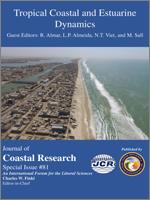Correia, J.R.M.B.; Oliveira, W.D.M.; Pereira, P.S.; Camargo, J.M.R., and Araújo, M.E, 2018. Substrate zonation as a function of reef morphology: A case study in Carneiros Beach, Pernambuco, Brazil. In: Almar, R.; Almeida, L.P.; Trung Viet, N.; and Sall, M. (eds.), Tropical Coastal and Estuarine Dynamics. Journal of Coastal Research, Special Issue No. 81, pp. 1–9. Coconut Creek (Florida), ISSN 0749-0208.
Beachrocks or Sandstones reefs are characteristic formations of the northeast coast of Brazil. In addition to their ecological function (e.g., shelter for other organisms), they have an important economic and scientific value. A single topographic survey and reef's substrate identification was performed along 22 profiles (with 40 m spacing), using kinematic DGPS, in the Carneiros Beach's beachrock, located at the mouth of Formoso River (Pernambuco, Brazil). The aim of this survey was to characterize the reef's topography and its benthic cover. The consolidated substrate is located in the intertidal zone, between +2.02 and −1.66 meters depth contours. According to the topography, three sub-environments were identified: backreef, reef crest and forereef. The backreef was found to be the narrowest, with a steep slope on the ocean side. The reef crest showed a low variation in substrate cover while the forereef showed a greater variation and the largest width. Over the measured profiles 11 categories of reef substrate cover were identified. A clear distribution patterns were observed in sea urchins, seaweeds, scleractinian corals and the soft corals Palythoa caribaeorum, as well as a sparse occurrences in the hydrocoral Millepora alcicornis and sponges. It was observed that the pattern of distribution of algae and hard corals were related to the local hydrodynamic conditions. The results of this study indicate that several factors can influence the spatial distribuition of the benthic cover. On the reef profiles studied, we observed a substrate zonation relating to the air exposure gradient, variation of tides, unconsolidated substrate deposition and wave action. In addition to these environmental factors, anthropogenic actions, such as trampling, may be responsible for changes in this environment. This study represents a baseline for future surveys of the spatial distribution of organisms.





